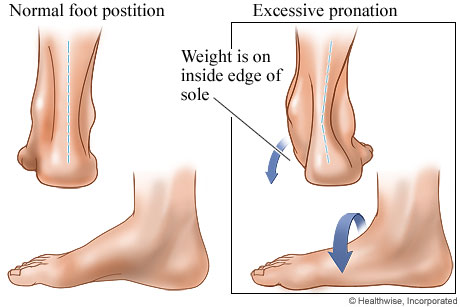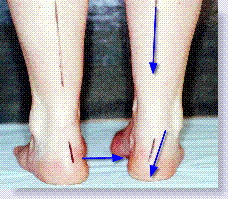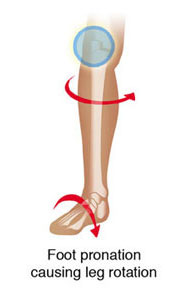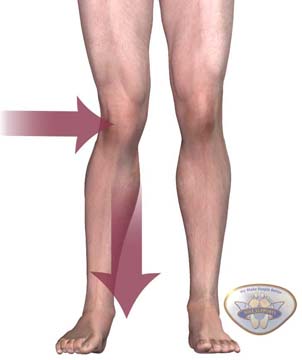20 May 2010
Foot Pronation and the Figure Skater
Lauren Downes MSPT
There are many factors that will affect a figure skater's ability to perform jumps, spins, and various moves with correct technique. One would consider lask of muscle strength or flexibility, poor coordination, lack of sound technique, or poor concentration. Those with a biomechanically oriented mind will automatically think of a skater's alignment and body mechanics, looking at the skater from the bottom up. This may start by looking at the skater's feet and ankles.
There are two different types of foot dysfunction: over-pronation (pes planus) and over-supination (pes cavus). A person who overpronates presents with an arch that is flatter, more flexible, and closer to the ground than normal. One who oversupinates presents with an arch that is higher and more rigid than normal. For this article, only pronation will be discussed.
Pronation  Supination Supination 
Pronation occurs from the joint between the tibia bone (lower leg) and the talus (ankle bone), and the joint between the talus and the calcaneous (heel bone). As the foot flattens, the ankle will cause the tibia to rotate inward. (See picture #1 below). As the tibia rotates inward, this will affect angle of the knee joint. When the knee joint turns in more the normal, this is called an increase in the valgus angle of the knee.(see picture #2). When a skater bends the knee, this phenomena increases, and the valgus angle gets larger.
#1.  #2 #2
Now picture how many times you see a skater bending into a deep knee bend on the ice: all the time! The biomechanics of the knee, ankle, and hip are involved in almost everything a skater does, notably jump entrances and landings, spin positions, basic turns, and stroking. If a skater has anatomical abnormalities such as excessive foot pronation, the entire kinetic chain of movement will be affected, making it difficult to achieve positions that are 'technically correct' in numerous skating moves. Think of the frustrated coach who attempts to correct a skater's technique, yet that skater cannot complete the correct positions due to poor biomechanics.
Let's take a lutz jump as an example. Skater A is riding backwards on a solid outside edge, preparing for the takeoff. As she reaches back and bends the skating knee, she immediately flips to an inside edge and must alter her shoulder and hip position to compensate. Skater A's coach notices that Skater A's knee turns inward as she is bending. This could result from two problems: pronation and/or hip weakness. The pronation could cause the knee to turn inward, making the opposite hip drop. This will shift the skaters weight to the inside edge, resulting in an incorrect lutz takeoff. How do we rectify this situation?
How Do We Correct Pronation?
The most ideal way to correct pronation is through a pair of custom fitted orthotics. A podiatrist, orthotist, or physical therapist who specializes in orthotic prescription will cast the foot, measure various angles of the foot and ankle joints, and evaluate a skater's gait pattern. This will result in a customized arch support that will prevent the foot from over-pronating and reduce the stress angle at the knee. The negative is, orthotics cost between $300-$400, which is a large expense. A young skater is also consistently growing, and may outgrow the expensive pair of orthotics in less than a year's time. Orthotics can be a big investment that last for a short time period. An adult skater or a teenager who has passed his or her growth spurt will be able to use the orthotics for several years, increasing the value of the investment. An additional option for a young skater or a skater's family that may not be able to afford custom orthtics is a non-custom brand. The 'Superfeet' brand has created an arch support specifically made for skates, which can be trimmed to fit comfortably into the skate. This type of arch supoort is firm and will prevent the arch from collapsing in the skate. The negative to a non-custom arch support is the lack of differentiation between supporting forefoot versus rearfoot motion. In some skaters, pronation is caused by too much movement in the front of the foot, as opposed to the back of the foot. A custom orthotic will address the rear or forefoot movement with posting or wedging. You may find some experienced boot fitters who are able to add posting to a superfeet brand.
Pronation can also be affected by a skater's gastroc and soleous flexibility in the calf, which can be addressed by simple stretching. In conclusion, it is very important to address over-pronation in any level of figure skater. Simple biomechanical correction will help to improve technique and balance, prevent knee or back pain, and allow the skater to maximize his or her skating potential.
|